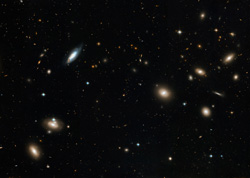Hubble’s sweeping view of the Coma Galaxy Cluster

Hubble’s Advanced Camera for Surveys has viewed a large portion of the Coma Cluster, stretching across several million light-years across. The entire spherical cluster is more than 20 million light-years in diameter and contains thousands of galaxies. Most of the galaxies that inhabit the central portion of the Coma Cluster are elliptical galaxies. These featureless “fuzz-balls” are a pale golden brown in colour and contain populations of old stars. Both dwarf and giant ellipticals are found in abundance in the Coma Cluster.
Also known as Abell 1656, the Coma Cluster is over 300 million light-years away. The cluster, named after its parent constellation Coma Berenices, is near the Milky Way’s north pole. This places the Coma Cluster in an area that is not obscured by dust and gas from the plane of the Milky Way, and so is easily visible to observers here on Earth.
Most of the galaxies that inhabit the central portion of the Coma Cluster are elliptical galaxies. These apparently featureless “fuzz-balls” are a pale golden brown in colour and contain populations of old stars. Both dwarf and giant ellipticals are found in abundance in the Coma Cluster.
Farther out from the centre of the cluster there are several spiral galaxies. These galaxies contain clouds of cold gas that are giving birth to new stars. Spiral arms and dust lanes “accessorise” these bright bluish-white galaxies, which have a distinctive disc structure.
S0 (S-zero) galaxies form a morphological class of objects between the better known elliptical and spiral galaxies. They consist of older stars and show little evidence of recent star formation, but they do show some structure — perhaps a bar or a ring that may eventually give rise to more disc-like features.
This Hubble image consists of a section of the cluster that is roughly one-third of the way out from the centre of the whole cluster. One bright spiral galaxy is visible in the upper left of the image. It is distinctly brighter and bluer than the galaxies surrounding it. A series of dusty spiral arms appears reddish brown against the whiter disc of the galaxy, and suggests that this galaxy has been disturbed at some point in the past. The other galaxies in the image are either ellipticals, S0 galaxies or background galaxies that are far beyond the Coma Cluster sphere.
The data for the Coma Cluster were taken as part of a survey of a nearby rich galaxy cluster. Collectively they will provide a key database for studies of galaxy formation and evolution. This survey will also help to compare galaxies in different environments, both crowded and isolated, as well as to compare relatively nearby galaxies with more distant ones (at higher redshifts).
Media Contact
More Information:
http://www.spacetelescope.org/news/html/heic0813.htmlAll latest news from the category: Physics and Astronomy
This area deals with the fundamental laws and building blocks of nature and how they interact, the properties and the behavior of matter, and research into space and time and their structures.
innovations-report provides in-depth reports and articles on subjects such as astrophysics, laser technologies, nuclear, quantum, particle and solid-state physics, nanotechnologies, planetary research and findings (Mars, Venus) and developments related to the Hubble Telescope.
Newest articles

A universal framework for spatial biology
SpatialData is a freely accessible tool to unify and integrate data from different omics technologies accounting for spatial information, which can provide holistic insights into health and disease. Biological processes…

How complex biological processes arise
A $20 million grant from the U.S. National Science Foundation (NSF) will support the establishment and operation of the National Synthesis Center for Emergence in the Molecular and Cellular Sciences (NCEMS) at…

Airborne single-photon lidar system achieves high-resolution 3D imaging
Compact, low-power system opens doors for photon-efficient drone and satellite-based environmental monitoring and mapping. Researchers have developed a compact and lightweight single-photon airborne lidar system that can acquire high-resolution 3D…





















